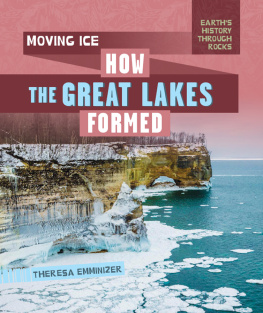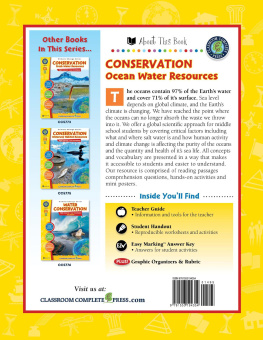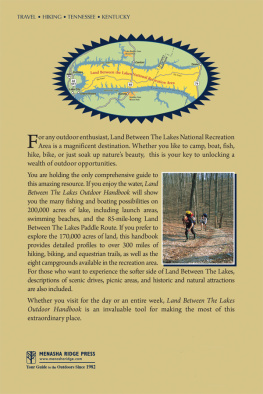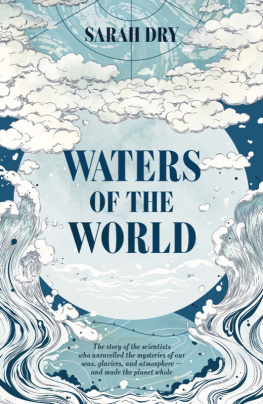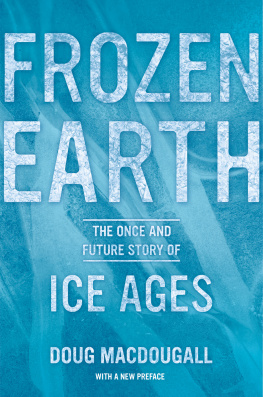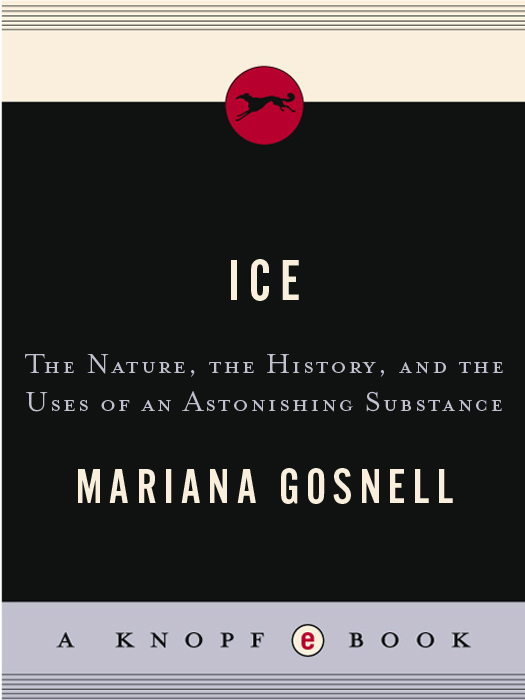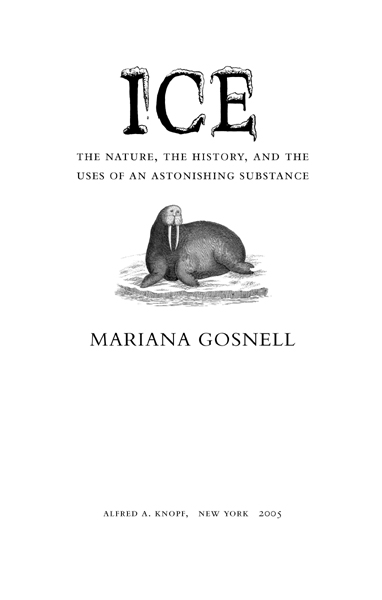ALSO BY MARIANA GOSNELL
Zero Three Bravo:
Solo Across America in a Small Plane

THIS IS A BORZOI BOOK
PUBLISHED BY ALFRED A. KNOPF
Copyright 2005 by Mariana Gosnell
All rights reserved. Published in the United States by Alfred A. Knopf, a division of Random House, Inc., New York, and in Canada by Random House of Canada Limited, Toronto.
www.aaknopf.com
Knopf, Borzoi Books, and the colophon are registered trademarks of Random House, Inc.
Owing to space limitations, permissions credits can be found following the index.
Library of Congress Cataloging-in-Publication Data
Gosnell, Mariana.
Ice : the nature, the history, and the uses of this astonishing substance / Mariana Gosnell.1st ed.
p. cm.
eISBN: 978-0-307-79146-7
1. IcePopular works. I. Title.
QC926.32.G67 2005
551.31-dc22 2005045126
v3.1
For Doug, Steve, Kathy, and Scott, my nephews and niece,
whose earliest exposure to ice outside a glass of lemonade
was the frozen surface of the Olentangy and
Scioto rivers in Columbus, Ohio
Let the Brazos
Freeze solid! And the Wabash turn to a leaden
Cinder of ice!
John Ashbery,
Into the Dusk-Charged Air
As if everything in the world is the history of ice.
Michael Ondaatje,
Coming Through Slaughter
Contents
INTRODUCTION
Keep your eye clear
as the bleb of the icicle
Seamus Heaney,
North
I T STARTED WITH an ice cube. I happened to be looking at an ice cube floating in a glass of iced tea one day when it came to me: hard waterwhat a concept! I stared at the cube, and in the center of it I saw a little round whitish fuzzy-edged ball, like a wad of spider silkwhat was that? Looking more closely, I noticed the ball had some wavy, petal-like layers in it and a smoky trail leading out toward one edge. Most of it was gloriously clear, though, with only tiny sprays of elongated bubbles, and light shone off the bubbles and through the clear part and played on the outside surface. Such a strange and beautiful object!
Not long afterward, I went on a story assignment to an ice island in the Canadian High Arctic, where ice experts from oil companies were doing large-scale tests on ice. Before they set up drilling rigs in waters off the coasts of Newfoundland and Alaskacommonly called ice-infested waters, as if the ice were rats or insectsthey needed to know more about what would happen if ice hit a rig or if a tanker hit ice. The island was a 3,000-year-old, five-mile-long slab of mostly freshwater ice which had broken from an ice shelf off Ellesmere Island eight years earlier and had been drifting in the company of sea ice ever since. By the time the Canadians set up a research camp on it, it was fewer than 600 miles from the North Pole. Except for a few low peaks sticking up off Ellef Ringnes, a rocky island in the distance named for a Norwegian beer manufacturer who supported early Arctic expeditions, the landscape surrounding the campthe ice island, the sea ice attached to itwas more or less flat in all directions. And except for those low peaks and a few dark nuggets lying on top of the snow cover, clues that Arctic foxes had been coming around, the landscape was all white under 24-hour-a-day sunlight.
The tests were meant to mimic a sudden collision between ice and a metal rig or tanker, so that researchers would have an idea what damage the ice could do to the metal and the metal to the ice. After sawing a ten-foot-deep, 300-foot-long trench in the ice, engineers lowered into its glowing blue-green interior what was essentially a giant hammer (an indenter) with a metal plate about the thickness of a ships hull on its face and wires running to computers from sensors on the plate. Somebody flipped a switch, and with a shudder and a restrained crunching noise, the indenter hit one wall of the trench with a million pounds per square inch of force, equal to the weight of a thousand small cars sitting on top of each other, one engineer said. When the indenter was pulled away from the wall minutes later, the metal plate had a dent in it the size of a saucer and the wall had a circle of crushed white ice on it the size of the plate. Running through the white, however, was a large swirl of the same blue-green as the surrounding wall, indication that the ice there had not been crushed; in outline it looked rather like a map of Newfoundland.
Before the next test, a three-day blizzard set in, and nobody could go anywhere without risk of being lost in a whiteout. The ice experts, from universities and government as well as oil companies, sat around in their plywood huts with socks drying on the bunk beds and enormous cooking pots of snow heating on the stoves (for wash water), telling me things about ice when I asked, some things sounding like tall tales: ridges of sea ice sticking 60 feet up off the surface of the ocean; icebergs the size of pianos moving as fast as men running; a wire being pulled through a bar of solid ice without cutting it in two; a beam of ice hanging in a cold room with a weight on one end and stretching, like taffy in slow motion, until it was more than twice as long as before; ice gripping boulders on river bottoms and carrying them up to the surface Ice is fascinating, they said. In some ways unique. Changeable, idiosyncratic, complex.
It is more brittle than glass. It can flow like molasses. It can support the weight of a C-5A transport plane. A child hopping on one leg can break through it. It can last 20,000 years. It can vanish in seconds. It can carve granite. It can trace the line of a windowpane scratch. It can kill peach buds. It can preserve mammoths for centuries, peas for months, human hearts for hours.
One ice expert, a physicist from India whose name in Sanskrit means crystal clear, told me something that sounded particularly far-fetched: that ice is not, as a person would reasonably assume, a low-temperature material, the ultimate in cold things, but a high-temperature one. Even the coldest piece of glacial ice is close to its melting point, within 50F of it. Steel, when we encounter it, unless we work in a foundry, is 2,700F from its melting point; metamorphic rocks are over 3,000F from theirs. Some of the paradoxical aspects of ice derive from this happenstance. Ice, in its own terms, is hot.
Also, it floats, or swims, in its own melt. This rare behavior comes from the way water molecules are linked in ice crystals, so that they form wide-open hexagons. Since a crystals outward shape usually reflects its molecular structure, we get the six-sided snow crystal. These glorious spangles, Henry David Thoreau wrote of fresh snow crystals lying upon a meadow, the sweepings of heavens floor. And they all sing, melting as they sing, of the mysteries of the number six; six, six, six. The word crystal itself comes from the Greek for clear ice, krystallos, first given to the mineral quartz because the ancients thought it actually was ice, water frozen in extreme cold.
Once I became hooked on the subject, I learned that several great men in the history of science and thought have given attention to ice, along with everything else they were doing. Michael Faraday, pioneer in electricity and magnetism, studied the surface properties of ice after pondering why it is that snow crystals glom together into a snowball. Astronomer Johannes Kepler concluded (and was probably the first in Europe to do so) that snow crystals are hexagonal and symmetrical and not by chance, but although he tried hard to figure out why, he couldnt. Mathematician Ren Descartes also tried (and was wrong), yet he made what were perhaps the first scientifically accurate drawings of snow crystals. Physicist Galileo Galilei demonstrated during a public debate on the nature of floating bodies that


